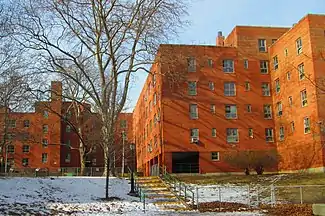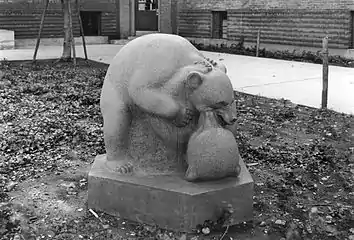Harlem River Houses
The Harlem River Houses is a New York City Housing Authority public housing complex located between West 151st and 153rd streets and between Macombs Place and the Harlem River Drive in Harlem, Manhattan, New York City. The complex, which covers 9 acres (3.6 ha), was built in 1936-37 and opened in October 1937[3] – one of the first two housing projects in the city funded by the Federal government – with the goal of providing quality housing for working-class African Americans.[1] It has 574 apartments.[3]
Harlem River Houses | |
 Seen from Harlem River Drive walkway (2014) | |
   | |
| Location | West 151st to 153rd Sts., Macombs Pl. and Harlem River Dr. Manhattan, New York City |
|---|---|
| Coordinates | 40°49′33″N 73°56′12″W |
| Area | 9 acres (3.6 ha) |
| Built | 1936-37[1] |
| Architect | Archibald Manning Brown (chief architect), et al.[1] |
| NRHP reference No. | 79001605[2] |
| NYCL No. | 0894 |
| Significant dates | |
| Added to NRHP | December 18, 1979 |
| Designated NYCL | September 23, 1975 |
The complex was designated a New York City Landmark in 1975[1] and was listed on the National Register of Historic Places in 1979.[2] In 2014 the complex was designated a Special Planned Community Preservation District, a zoning category created in 1974 "to preserve and protect ... superior examples of town planning or large-scale development."[4] The success of the project can be attributed to its formal, classically influenced design, to the project's focus on attracting a wide variety of tenants, not just the indigent, and to its "generous budget and high aspirations for quality."[3]
History
As originally planned public housing in New York City was segregated. After the Harlem Riot of 1935, there was pressure to improve housing for African Americans, but no general attempts were made to desegregate public housing. The Harlem River Houses were one of two projects which, for the first time, used Federal funds to construct public housing in New York City as part of Franklin D. Roosevelt's "New Deal" social program. The project was built by the Housing Division of the Public Works Administration at the cost of $4.5 million, a site owned by the Rockefeller family, which demanded twice the amount which Federal land acquisition guidelines would normally allow to be paid.[3] Eventually, community protests pushed the project ahead, and the property was taken by eminent domain[3] at the price of $1 million.[5]
The other project constructed at about the same time was the Williamsburg Houses in Brooklyn, intended for whites. The construction and opening of the two projects attracted national attention.[6] When the project was completed, 11,000 people applied for the 574 available apartments.[7] As of 1987, about 3 dozen of the tenants were part of the original group.[7]
When it opened, the project had child care, health care and a public community room on site. Rent in 1937 was $21.00 a month, and by 1939 was between $19.38 and $31.42 per month.[5] During the Reagan Administration, the rent was raised from 25% to 30% of a family's gross income.[7]
Architects

Archibald Manning Brown was the chief architect for the project. Other contributing architects included Will Rice Amon, Richard W. Buckley, Frank J. Forster, Charles F. Fuller, Horace Ginsbern,[8] and John Louis Wilson, Jr. one of the first African American architects to be registered in New York State.[1] Historians believe that Ginsbern, who had previously worked on the design of garden apartments along the Grand Concourse in the Bronx, was responsible for the project's overall layout.[3]
The landscape architects for the project were headed by Michael Rapuano.[8]
The primary sculptor involved in the design of the Harlem River Houses was Heinz Warneke, assisted by T. Barbarossa, F. Steinberger.[5] Richmond Barthé created the frieze Green Pastures: Walls of Jericho for the project, however they installed in 1941 at Kingsborough Houses, a mostly white project.[9][10][11]
Design
Each building in the complex is four or five stories tall and is set around landscaped open areas which include lawns, wide walkways, and recreation areas;[1] around two-thirds of the project's land is open space.[7] Those buildings with an additional story are built on a lower level, giving all buildings the same overall height. They are built from red brick, and have very little trim.[5]
The project is divided into three groups of buildings, two of which are west of Adam Clayton Powell Jr. Boulevard (Seventh Avenue), and one of which lies east of the avenue and west of the Harlem River Drive. All lie between West 151st and West 153rd Streets. The two western groups are each arranged around a large plaza, while the eastern group is more linear.[5] The formal layout is "reminiscent of a European park."[3]
The 9-acre Harlem River Houses are said to be the most successful public housing in New York City. The architects designed modern, spacious buildings which, according to architecture critic Lewis Mumford, provided:
the equipment for decent living that every modern neighborhood needs: sunlight, air, safety, play space, meeting space, and living space. The families in the Harlem Houses have higher standards of housing, measured in tangible benefits, than most of those on Park Avenue.[8]
Another contemporary critic said of the complex:
The whole, in detailing, looks tired – as if the creative drive and the creator's pleasure, which had sailed so triumphantly through the period of general planning and design, had suddently failed when it came to the last, completing touches. Harlem River Houses is so generally beautiful that one longs for it to be perfect. What might have been great architecture is merely - very good.[12]
Notable residents
- Lemoine Deleaver Pierce (1934–2015), educator and mediator
See also
- List of New York City Housing Authority properties
- List of New York City Landmarks
- National Register of Historic Places listings in New York County, New York
- New York City Housing Authority
References
Notes
- New York City Landmarks Preservation Commission; Dolkart, Andrew S.; Postal, Matthew A. (2009). Postal, Matthew A. (ed.). Guide to New York City Landmarks (4th ed.). New York: John Wiley & Sons. ISBN 978-0-470-28963-1..204
- "National Register Information System". National Register of Historic Places. National Park Service. March 13, 2009.
- Radford, Gail. "Harlem River Houses" in Jackson, Kenneth T., ed. (2010). The Encyclopedia of New York City (2nd ed.). New Haven: Yale University Press. p. 578. ISBN 978-0-300-11465-2.
- "Zoning Resolution" Archived 2006-10-03 at the Wayback Machine
- Federal Writers' Project (1939). "New York City Guide". New York: Random House. pp. 392–94. ISBN 978-1-60354-055-1. (Reprinted by Scholarly Press, 1976; often referred to as WPA Guide to New York City.)
- McLeod, Darlene K., Olshansky, Joan R., and Spencer-Ralph, Elizabeth (July 1979). "National Register of Historic Places Registration: Harlem River Houses". New York State Office of Parks, Recreation and Historic Preservation. Retrieved March 26, 2011.CS1 maint: multiple names: authors list (link) See also: "Accompanying four photos".
- Dunlap, David W. "At 50, Harlem River Houses is Still Special." New York Times (April 23, 1987)
- White, Norval; Willensky, Elliot & Leadon, Fran (2010). AIA Guide to New York City (5th ed.). New York: Oxford University Press. p. 546. ISBN 978-0-19538-386-7.
- "Richmond Barthé & "Green Pastures: The Walls of Jericho"". NYC LGBT Historic Sites Project. Retrieved June 28, 2019.
- "An Iconic Harlem Renaissance Frieze Is Crumbling in Brooklyn". Hyperallergic. November 29, 2018. Retrieved June 28, 2019.
- Vendryes, Margaret Rose (2008). Barthé: A Life in Sculpture. Univ. Press of Mississippi. ISBN 9781604730920.
- Hamlin, T. E. in Pencil Points, quoted in Federal Writers' Project (1939). "New York City Guide". New York: Random House. pp. 392–94. ISBN 978-1-60354-055-1. (Reprinted by Scholarly Press, 1976; often referred to as WPA Guide to New York City.)
External links
| Wikimedia Commons has media related to Harlem River Houses. |
- Wolf, Eric. "Black History Month, with a Tribute to John L. Wilson Jr. and the Harlem River Houses" Black History Month Celebration. 2000. LaGuardia & Wagner Archives. (October 2, 2006)
- Harlem River Houses, United States Housing Authority. 1937
- Harlem River Map
- Harlem River II Map

